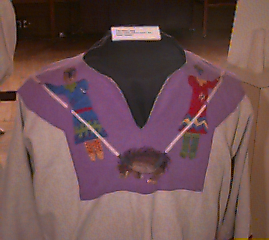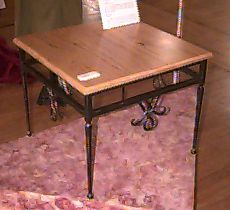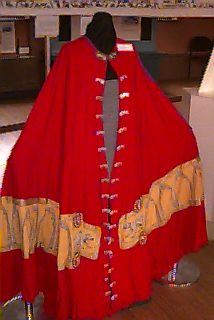



This is Karen's first showing at a public exhibition, although she has been doing medievally-inspired embroidery for ten of her thirteen years membership in the Society for Creative Anachronism (recreating the Middle Ages from 600-1600). Karen, being a writer by profession, has no background in graphic arts, and came to her self-taught sewing skills relatively late in life solely as a result of her SCA activities. Having been very reluctant to learn to sew as a child, no one is more surprised than she is at being involved in an exhibit of this nature, on the basis of her needlework.
"Because the SCA aims at studying aspects of medieval life through hands-on experience with creative and domestic arts and sciences, Society members often spend a great deal of time studying period artifacts. In the case of my embroideries, this often means studying embroidered or woven textile finds from bogs and burials (such as the Norse funeral Tapestry from the Oseberg ship burial), as well as surviving examples such as the Bayeau Tapestry, and re-creating the techniques and tools as closely as possible.This progression of study is visible in the pieces of Karen's presentation, which sample designs, techniques, and materials from the three dominant Dark Age cultures in England prior to the Norman Conquest of 1066"

The design is an original, done in a loose approximation of the Oseberg Tapestry style of figures, dated to 820. This piece, showing the Norse god Odin One-Eye and a companion using ash spears to slay a boar (often associated with the god Frey, the closest thing the Norse had to a god of Peace), was done separately as an embellishment for the shirt. The human figures are worked in varying fill stitches, using 2-strand GM cotton floss and metallic gold; the boar is worked in 1-strand spun mohair and metallic gold. The base fabric is a medium-weight cotton-linen blend.
The design, showing parent and offspring eagles, is modeled directly from the enameled pieces adorning a pouch lid, found in the Sutton Ho Saxon burial site, dated to the 11th Century. This piece is also worked separately as an embellishment for a shirt. The central birds are worked in 1-strand hand-dyed cottons using split and stem stitch fills. The dogs and man figures are worked in stem stitch outlines, using different 2-strand, hand-dyed cotton floss. The base fabric was originally bleached linen, but the eagles had to be transferred to natural linen after it was discovered that the floss dyes were not colorfast.
The design, showing a mother pelican piercing her breast to feed her chick, is an original done for this project by friend Richard Schweitzer. It is based on Celtic zoomorphic designs of the 6th-9th centuries. This piece is worked with 1-strand, 2-ply wool on a linen base, using split stitch as filler and open chain, or daisy, stitch for the feather layer. A large part of the project was done using various period-style, handcrafted brass or bone needles. In addition to the work on the neckline, additional Celtic knot work designs were added to sleeve and hem, done by couching Icelandic Lop wool directly to the tunic linen with the same thinner wool used in the embroidery.
David Robertson has been working with metals for 15 years. Now he resides and focuses on custom work at his studio outside of Car gill ( an hour and a half north of Kitchener-Waterloo), where he makes his living as a full time blacksmith. A graduate of the University of Waterloo's Engineering program, David has been fascinated by the manipulation of the physical world since an early age. He could often be found tearing apart an appliance or electrical device, (most of these were reassembled minus five or six nonessential parts), or creating some useful project from scrap materials. This combination of inquisitiveness and history of working with his hands lead him to his interest in blacksmithing and engineering. At The beginning of his career David developed an interest in early middle ages re-enactment, particularly Celtic and Norse culture and artifacts. He would often sell smaller utensils and tools which he had made, based on those common in that era. In 1996 David was honoured with an invitation to become Joeseph Schneider Haus 'Folk Artist In Residence'. This position included setting up a gallery display entitled 'The Schneiders and the Smiths at Schneider Haus Museum', conducting courses at the museum, a lecture series, as well as numerous demonstrations through out his term. For years prior to this appointment David had performed demonstrations for the public at various fairs and shows, and also teaching courses from his studio.
Since the beginning of his blacksmithing career David has worked on projects as diverse as nickel damascus knives to artistic gates and functional furniture. He has shown his work in galleries in Ontario as well in the United States. Currently organic motifs especially catch his interest. "When the steel is hot it takes on a natural fluid grace. Gentle coaxing with hammer and anvil allow the steel to be transformed into vines and leaves that echo the beauty found in nature. "In this gallery showing, the Bayeux Tapestry was used as the source for inspiration. "I chose to use the Tapestry as a motif spring board. The works I created draw on specific shapes found in the tapestries and then I build and add details to create functional artistic objects."
This grill was inspired by the wagon wheel in the Tapestry. The eight spokes radiating out >from a central hub. The points of the spokes are created in the same shape as the kite shields of the Normans. This grill could have been used in a circular church window - or it could be mounted on a plain wall as a decorative accent. Each piece has been hammered to shape using traditional techniques with forge, hammer and anvil. The actual joiner is done with modern equipment.

The coffee table is forged and fabricated from solid bar. The basic shape is a classic design, with the decorative elements are inspired from the Tapestry. The interlacing of the forged rods was inspired by the interlacing of the branches on the trees in the Tapestry. The wooden top was made from spalted elm, the black lines of the spalting accenting the dark grays of the steel base.
The candelabrum was in part inspired by the curvature of the table at the feast shown on the Tapestry. I incorporated this curvature into the opposing curved and flattened bars that pierce the central stand. The bars were then drawn out into long tapers that are wrapped around the central support - all traditional hot forging techniques. The candles spiraling around the outside of the are reminiscent of the flow of the tree branches in the trees found on the Tapestry.
Among other things Lorina is a textile artist, having pursued the art of embroidery for 41 years. Her work as a watercolourist, oil artist and graphic designer has appeared in one-woman and group exhibitions since 1980, with this being her first exhibition of textiles - what for her is a natural progression and marriage of art and a deep regard for history and historic technologies. Influenced by the works of opus anglicanum, a body of ecclesiastical embroideries from 800 to 1500 A.D., of which the Bayeux Tapestry is a part, Lorina attempts to capture that sense of majesty and mystery so evident in these peerless embroideries. Working on reproduction embroidery frames, both large (six feet) and small (six inches), Lorina fashions garments and hangings employing time-honoured historic methods with time-honoured historic tools and materials.

"Cloak of State" is made in the style of opus anglicanum. It is constructed of red silk noil, embroidered on a ground of yellow silk noil with spun silk serica threads, gold metallic and real metal, embellished with freshwater pearls, carnelians and handcast pewter bears down the front. Some useless but interesting trivia: embroidery is worked at 800 stitches per square inch, comparable to the works of opus anglicanum; approximately 105,000 stitches in the embroidery; weight 5.5 lbs.; approximately 1.152km of embroidery thread; approximately 20 yds of gold metallic trim; approximately 176 carnelians; approximately 176 freshwater pearls; approximately 900 hours labour (!)
Influenced by a 6th century Swedish tomb carving, the scarf is black silk satin with a silk and ecclesiastical grade gold purl embroidered linen applique. Two onyx stones add dimension in the upper corners of the embroidery, along with fresh water pearl eyes on the stylized deer. Pulled gold purl delicately entwines the applique. The fringed ends are of red and black silk with gold metallic threads.
